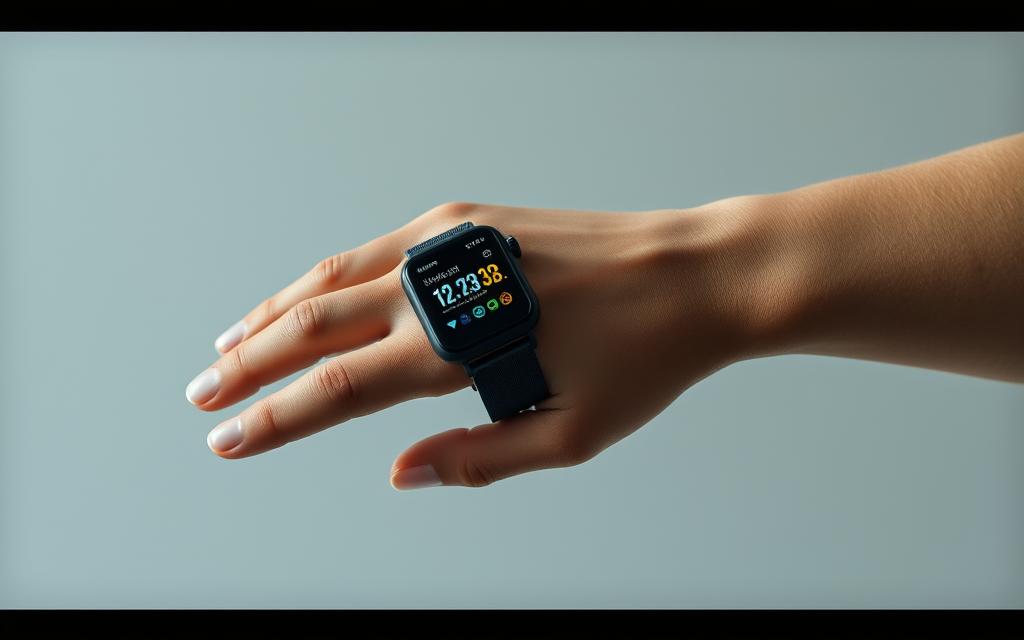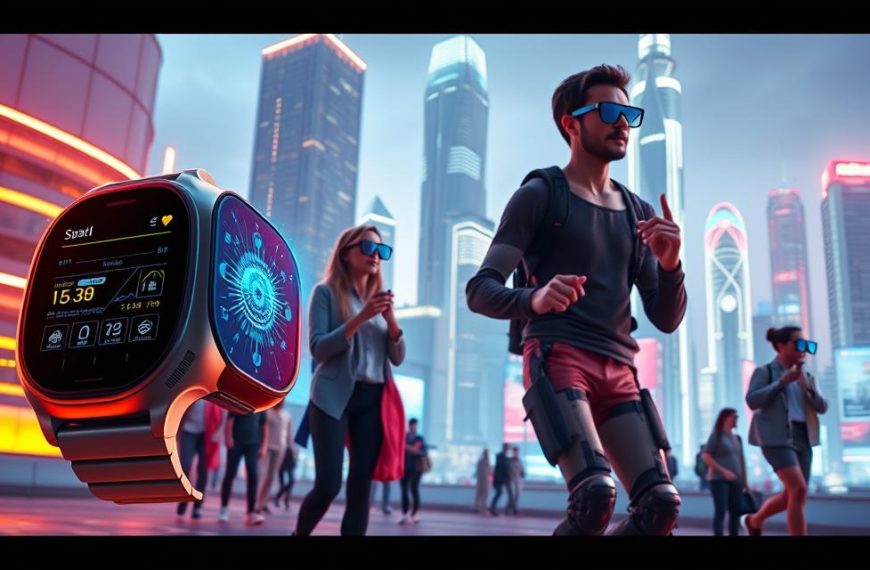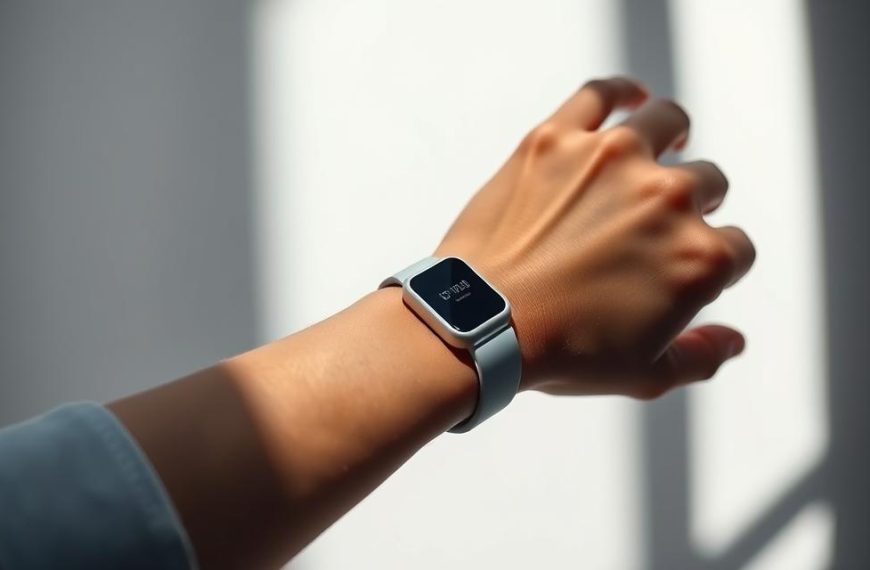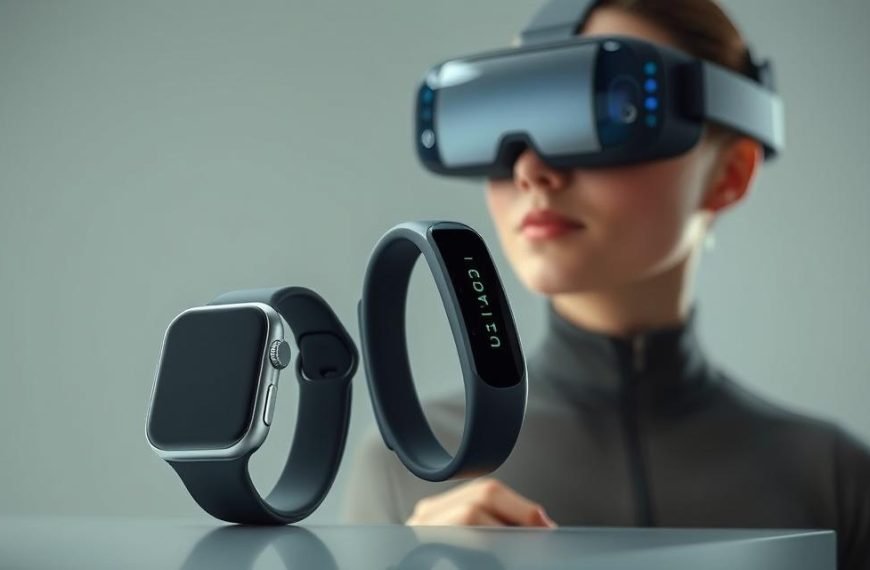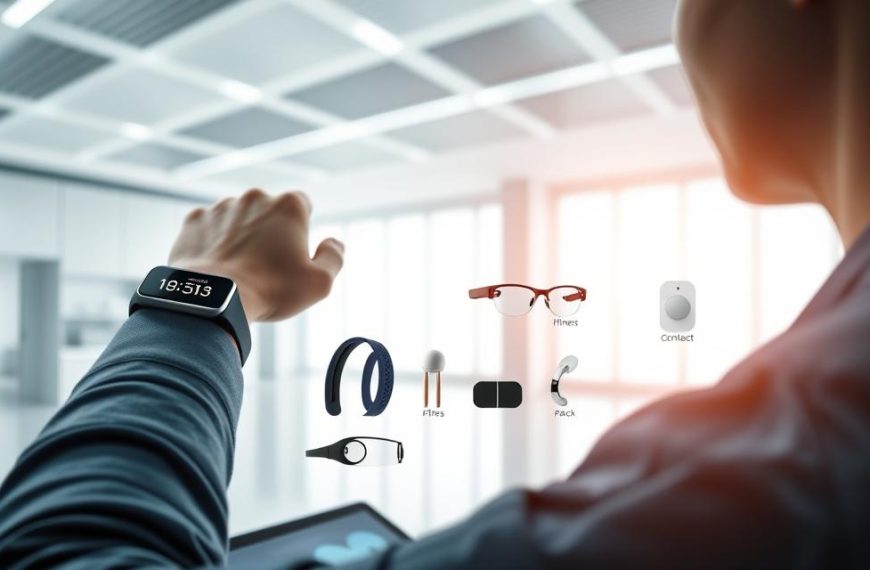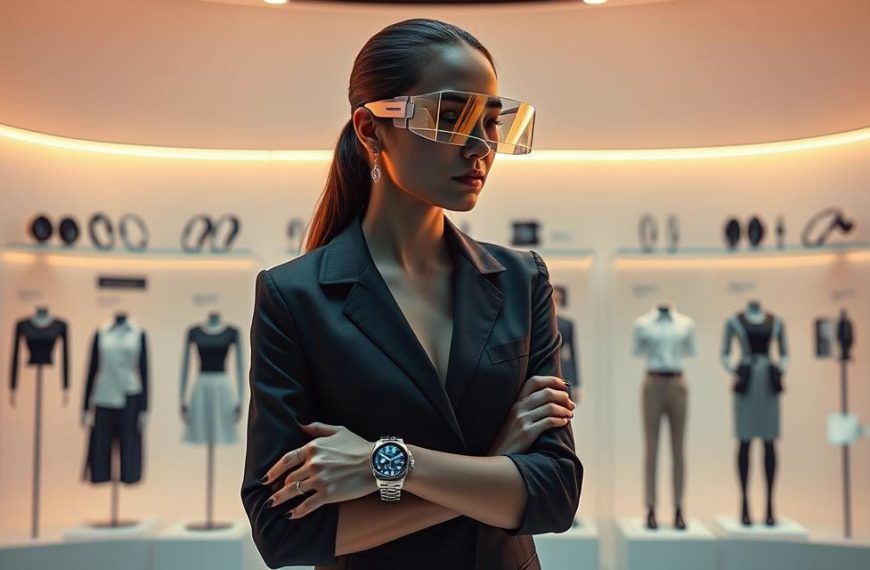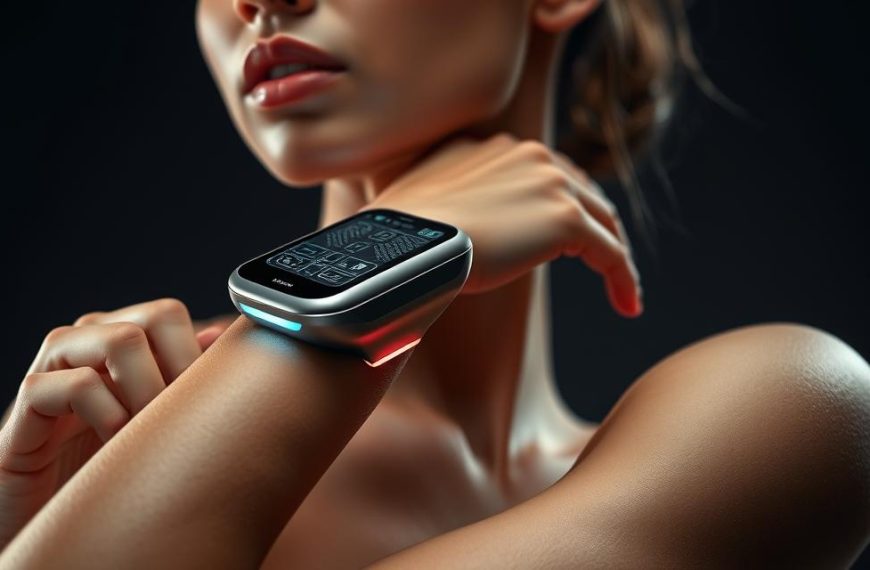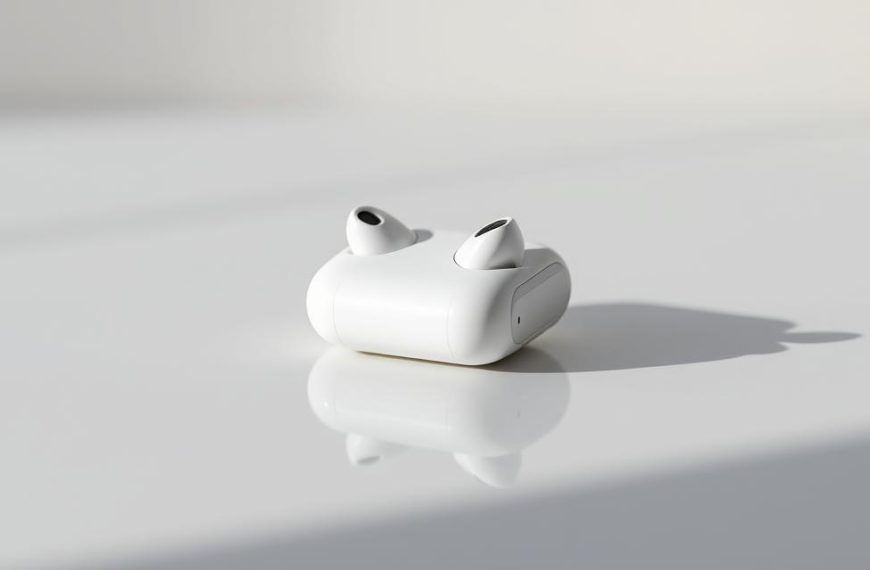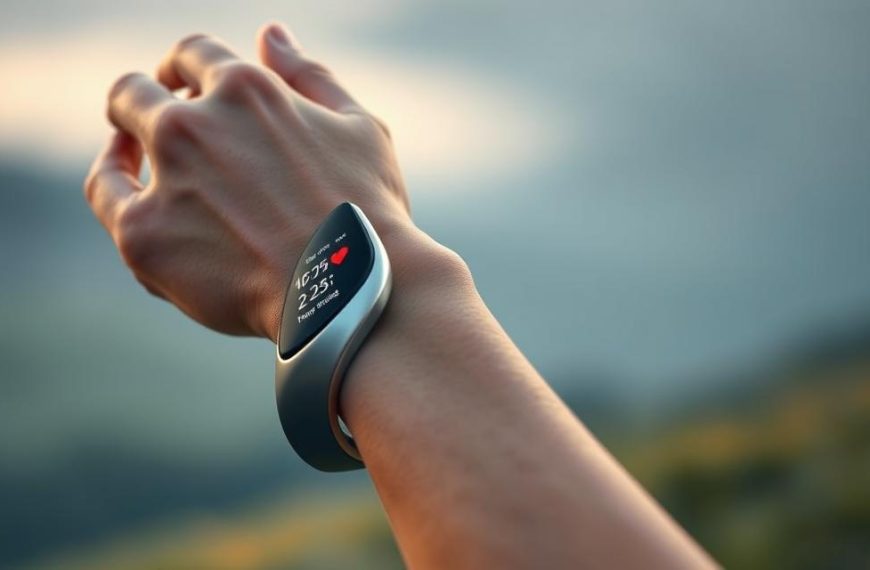Wearable technology refers to body-worn electronics designed to process and transmit information. These devices, like the Apple Watch Series 9 and Fitbit Charge 6, rely on three key components: sensors, data handling, and wireless communication.
Sensors collect real-time information, such as heart rate or movement. Data is then processed and analyzed to provide actionable insights. Connectivity ensures seamless integration with smartphones, IoT ecosystems, and 5G networks.
The market for these devices is booming, projected to reach $186 billion by 2030. They are transforming industries, from healthcare to fitness and enterprise. Wearables have evolved from simple pedometers to advanced, AI-powered tools.
FDA-cleared medical wearables, like ECG monitors, are now essential in digital health strategies. This article dives into the technical mechanisms behind these innovations, offering a deeper understanding of their functionality.
Introduction to Wearable Technology
From smartwatches to medical patches, wearable tech is transforming daily life. These devices, worn as accessories or integrated into clothing, have evolved significantly since the 13th century. What began with eyeglasses has now expanded to include advanced augmented reality headsets and AI-powered hearing aids.
Today, wearable tech falls into two main categories: consumer devices and medical-grade tools. Consumer wearables, like the Apple Watch, focus on fitness and convenience. Medical-grade devices, such as continuous glucose monitors, prioritize health management. Both types cater to the needs of users across various industries.
Adoption rates are soaring. According to Pew Research, 30% of U.S. adults now use smartwatches. This growth reflects a shift from single-purpose devices to multifunctional tools. Modern wearables sync seamlessly with smartphone ecosystems, enhancing their utility.
Key players dominate the market. Apple leads with a 34% share, followed by Samsung, Garmin, and Withings. Emerging form factors, like smart rings and hearables, are gaining traction. The pandemic accelerated demand for health-focused wearables, making them essential for many people.
Beyond consumer and medical applications, wearable tech has found its way into the military. Smart boot inserts, for example, monitor load distribution for soldiers. However, this rapid growth raises ethical concerns. Issues like data privacy and workplace monitoring need careful consideration.
What is Wearable Technology?
Wearable devices are revolutionizing the way we interact with our health and environment. These body-mounted computers combine sensing and communication capabilities to provide real-time insights. They are equipped with microprocessors, batteries, and internet connectivity, allowing them to sync with other devices effortlessly.
At their core, these devices rely on embedded sensors like accelerometers and optical heart rate monitors. These components track movements, monitor vital signs, and collect data for analysis. The integration of Micro-Electro-Mechanical Systems (MEMS) has enabled the miniaturization of these technologies, making them compact and efficient.
Wearable tech can be categorized into two main types: accessory-based and clothing-integrated. Accessory-type devices, such as smartwatches and fitness bands, are worn on the wrist or as jewelry. Clothing-integrated devices, like Hexoskin’s biometric shirts, embed sensors directly into fabrics, offering a seamless user experience.
Material innovations have also played a crucial role. Flexible circuits and washable electronics ensure durability and comfort. Some devices are disposable, like skin patches that transmit patient data wirelessly, while others, such as smartwatches, are rechargeable and designed for long-term use.
Regulatory classifications further define these devices. For example, FDA Class II medical devices include advanced tools like continuous glucose monitors. Hybrid innovations, such as Bose Frames, combine audio functionality with eyewear, showcasing the versatility of wearable tech.
However, not all body-worn electronics qualify as wearable technology. Basic digital watches without connectivity lack the advanced features that define modern devices. For a deeper understanding of this evolving field, explore wearable technology.
How Does Wearable Technology Work?
The functionality of today’s wearable devices hinges on three core elements: sensors, data, and connectivity. These components work together to deliver real-time insights and enhance user experiences.
Role of Sensors in Wearable Devices
Sensors are the backbone of these devices, capturing biometric and environmental data. Common types include:
- Photoplethysmography (PPG): Monitors blood flow and heart rate using optical measurements.
- Bioimpedance sensors: Analyze body composition by measuring electrical resistance.
- MEMS accelerometers/gyroscopes: Track movement and orientation for fitness trackers.
- Environmental sensors: Measure SpO2, UV exposure, and air quality.
Data Collection and Processing
Once collected, data is processed either on-device or in the cloud. Advanced algorithms analyze patterns and fuse inputs from multiple sensors. For example, FDA-cleared algorithms detect atrial fibrillation using ECG signals.
Connectivity in Wearable Technology
Seamless integration with other devices is enabled by modern connectivity standards:
- Bluetooth 5.3 Low Energy: Ensures energy-efficient communication.
- Wi-Fi 6/6E: Supports high-bandwidth data transfers.
- NFC: Facilitates contactless payments.
- ANT+: Pairs with fitness equipment for enhanced tracking.
- Emergency SOS: Provides cellular connectivity for urgent alerts.
These features ensure that wearable technology remains a vital tool in modern life.
Types of Wearable Devices
Modern body-worn electronics come in various forms, each tailored to specific needs. From smartwatches to headsets, these devices cater to diverse applications in health, fitness, and beyond.
Smartwatches like the Apple Watch Ultra and Fossil Gen 7 Wellness Edition dominate the market. They offer features like SpO2 monitoring and advanced fitness tracking. Comparisons between watchOS and Wear OS highlight their unique capabilities.
Fitness trackers such as the Garmin Venu 3 and Whoop 4.0 focus on specialized metrics. Multisport watches provide comprehensive data for athletes, while devices like the Whoop 4.0 emphasize recovery and strain analysis.
AR/VR headsets like the Microsoft HoloLens 2 and Meta Quest 3 serve both enterprise and consumer markets. The Varjo XR-4 targets professional use, while the Meta Quest 3 appeals to gamers and casual users.
Smart clothing, including Sensoria’s running socks and Nadi X yoga pants, integrates sensors into fabrics. These devices offer seamless tracking for active lifestyles.
Medical wearables like the Dexcom G7 CGM and Zio XT ECG patches are transforming healthcare. Smart inhalers from Propeller Health provide real-time data for asthma management.
Other categories include hearables like the Bose QuietComfort Ultra Earbuds, safety wearables like the Nimb Ring, and industrial gear such as the RealWear HMT-1 headset. Emerging innovations like Mojo Vision’s smart contact lens prototypes hint at future possibilities.
| Device Type | Example | Key Feature |
|---|---|---|
| Smartwatches | Apple Watch Ultra | SpO2 Monitoring |
| Fitness Trackers | Garmin Venu 3 | Multisport Tracking |
| AR/VR Headsets | Meta Quest 3 | Consumer Gaming |
| Smart Clothing | Sensoria Socks | Biometric Tracking |
| Medical Wearables | Dexcom G7 CGM | Continuous Glucose Monitoring |
Hybrid devices like the Fossil Gen 7 Wellness Edition combine multiple functionalities. These innovations highlight the versatility of modern wearable electronics.
Applications of Wearable Technology
From healthcare to entertainment, wearables are making a significant impact. These devices are no longer limited to basic fitness tracking. They now offer advanced features that cater to diverse needs, enhancing both health and leisure activities.
Health and Fitness Monitoring
Wearables have revolutionized health fitness by providing real-time data and actionable insights. Devices like continuous glucose monitors help diabetics manage their condition effectively. Post-operative recovery tracking tools, such as Activ Surgical Insights, ensure patients stay on the right path.
Mental health is also a focus. Heart rate variability (HRV) analysis helps users understand stress levels. For the elderly, fall detection systems in devices like the Apple Watch SE offer peace of mind. Remote patient monitoring platforms enable healthcare providers to track progress without in-person visits.
In fitness, wearables like the Garmin Epix Pro provide detailed metrics for triathlon training. Form Swim Goggles use haptic feedback to correct swimming techniques. Recovery rate calculations with the Whoop 4.0 ensure athletes optimize their performance. Integration with gym equipment, such as Peloton and Apple Watch, creates a seamless workout experience.
Entertainment and Gaming
Wearables are also transforming the entertainment industry. Spatial audio experiences with devices like the Apple Vision Pro immerse users in sound. Haptic gaming suits, such as the bHaptics Tactsuit X40, add a tactile dimension to gaming.
Augmented reality (AR) museum guides, like those powered by Google Glass Enterprise 2, enhance cultural experiences. Live events become more interactive with Snap Spectacles. VR fitness platforms, such as Supernatural VR, combine exercise with immersive environments, making workouts more engaging.
These applications highlight the versatility of modern wearables. They are not just tools for health and fitness but also gateways to enhanced leisure and entertainment.
Benefits of Wearable Technology
The benefits of wearable devices extend across health, productivity, and safety. These innovations are transforming the way people live, work, and stay active. From early health alerts to hands-free operations, wearables are making a significant impact.
Health monitoring is one of the most significant advantages. Devices like the Apple Watch can detect abnormal heart rhythms, reducing stroke risk by 34%. Continuous glucose monitors improve diabetes management by 27%, while post-COVID rehabilitation tracking ensures patients recover effectively.
In the workplace, wearables boost productivity. AR glasses speed up warehouse picking by 19%, and smart gloves reduce manufacturing errors by 22%. Real-time language translation tools help global teams communicate seamlessly, enhancing collaboration.
Safety is another critical area. Wearables can trigger emergency responses in 60 seconds, monitor driver fatigue, and alert users to hazardous environments like gas leaks. These features ensure people stay protected in high-risk situations.
Lifestyle enhancements are equally impressive. Sleep tracking optimizes rest by analyzing sleep stages. Stress management tools use heart rate variability (HRV) biofeedback to promote relaxation. Contactless payments through devices like the Apple Watch and Google Wallet simplify daily activity.
From improving health to boosting productivity and safety, wearable devices are enhancing every aspect of life. Their innovative features make them indispensable tools for modern living.
Challenges and Criticisms of Wearable Technology
While wearable devices offer numerous benefits, they also face significant challenges. These issues range from technical limitations to ethical concerns, impacting their adoption and effectiveness.
Technical limitations are a major hurdle. Even premium devices struggle with battery life, often lasting only 72 hours. During high-intensity workouts, heart rate monitors can show a 15% accuracy variance. Additionally, wearing devices 24/7 can cause skin irritation, limiting their usability.
Privacy and security are critical concerns. Many consumer devices lack full HIPAA compliance, leaving sensitive health data vulnerable. Third-party data sharing practices and location tracking risks further exacerbate these issues. Users must remain cautious about how their information is handled.
Social and ethical debates also arise. Workplace surveillance through wearables sparks discussions about employee rights. Insurance companies may use data to adjust premiums, raising fairness concerns. Additionally, the potential for digital addiction highlights the need for balanced usage.
Economic barriers add another layer of complexity. Medical-grade wearables often come with a 300% price premium, making them inaccessible to many. Repair complexity leads to increased e-waste, while subscription models create fatigue among users.
| Challenge | Example | Impact |
|---|---|---|
| Battery Life | 72-hour max in premium devices | Limited usability |
| Accuracy | 15% variance during HIIT | Unreliable data |
| Privacy | Third-party data sharing | Data vulnerability |
| Cost | $4,000+ for advanced hearing aids | Economic barrier |
“The integration of wearables into daily life must address these challenges to ensure user trust and long-term success.”
Addressing these issues is crucial for the future of wearable devices. By improving accuracy, enhancing security, and reducing costs, the industry can overcome these hurdles and continue to innovate.
The Future of Wearable Technology
The next wave of innovation in body-worn electronics is set to redefine how we interact with the world. Emerging technologies are pushing the boundaries of what smart devices can achieve, offering new features and capabilities that were once the stuff of science fiction.
In the near term (2024-2026), expect significant advancements. Solid-state batteries will double device runtime, while graphene-based sensors will enhance flexibility and accuracy. FDA-approved digital therapeutics will also become more prevalent, offering personalized health solutions.
Mid-term projections (2027-2030) include augmented reality contact lenses with display capabilities and self-powered kinetic energy harvesters. Epidermal electronics, lasting over 30 days, will provide continuous monitoring without the need for frequent replacements.
Looking further ahead (2031+), the long-term vision includes closed-loop insulin delivery systems and brain-computer interfaces for paralysis patients. Multi-sensory VR haptic feedback systems will immerse users in fully interactive environments, transforming entertainment and training.
Industry shifts are also on the horizon. Pharma-wearable partnerships, like Novo Nordisk and Dexcom, will drive innovation in healthcare. Automotive integration, such as BMW’s collaboration with Apple CarKey, will enhance vehicle connectivity. Military exoskeleton deployments will redefine soldier capabilities on the battlefield.
These advancements promise to reshape the world of body-worn electronics, offering unprecedented power and functionality. The future is bright, and the possibilities are endless.
Examples of Wearable Technology
The evolution of body-worn electronics has introduced a wide range of innovative devices. From fitness trackers to advanced medical tools, these wearables are reshaping industries and enhancing daily life. Below are some notable examples across various categories.
Consumer Electronics dominate the market with user-friendly designs. The Samsung Galaxy Watch 6 Classic offers advanced health features, while the Fitbit Luxe focuses on sleek fitness tracking. Razer Anzu smart glasses combine audio and UV protection for a unique experience.
Medical Devices are transforming healthcare. Abbott’s Libre Sense glucose sport biosensor provides real-time glucose monitoring for athletes. BioIntelliSense BioButton tracks multiple health parameters, and EssilorLuxottica’s Nuance Audio hearing glasses integrate hearing aid technology into stylish frames.
Enterprise Solutions are streamlining industries. Vuzix M4000 smart glasses enhance logistics with hands-free operations. ProGlove Mark 3 industrial scanners improve warehouse efficiency, and StrongArm Tech FUSE safety vests protect workers in hazardous environments.
Experimental Prototypes push the boundaries of innovation. MIT’s laser-based sweat sensor offers non-invasive health monitoring. Graphene-based smart tattoos provide flexible, long-term tracking, and Sony’s motion-sensing in-ear device introduces new possibilities for reality interactions.
| Category | Example | Key Feature |
|---|---|---|
| Consumer Electronics | Samsung Galaxy Watch 6 Classic | Advanced health tracking |
| Medical Devices | Abbott’s Libre Sense | Real-time glucose monitoring |
| Enterprise Solutions | Vuzix M4000 | Hands-free logistics |
| Experimental Prototypes | MIT’s Sweat Sensor | Non-invasive health monitoring |
These examples highlight the versatility and innovation of modern wearable devices. From consumer gadgets to medical breakthroughs, they continue to redefine how we interact with technology.
Conclusion
The integration of sensors, data, and connectivity has redefined personal health monitoring. These devices provide real-time insights, transforming how users manage their well-being. Continuous advancements are making healthcare more proactive and personalized.
However, innovation must balance with privacy concerns. As AI integration grows, devices will offer deeper analytics, enhancing the experience. Yet, sustainability challenges in production must be addressed to ensure long-term viability.
Consumers should prioritize security features when choosing technology. Regulatory frameworks will evolve to support medical-grade devices, ensuring safety and efficacy. The future lies in a harmonious relationship between humans and technology, fostering a healthier, more connected world.

